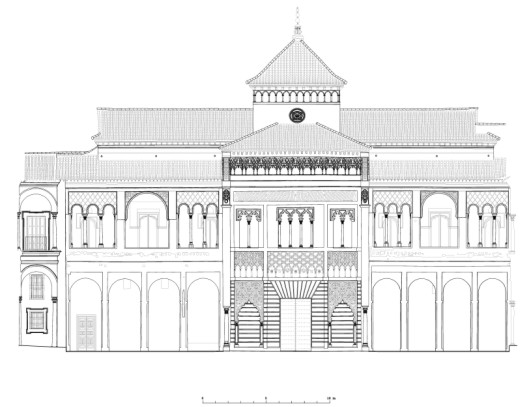Civil halls in Medina Azahara Palace are named as basilical halls, where we can see large halls with five parallel naves. Basilical space itself consists on three central naves, separated by two archery with a plain roof; all the naves have the same height. They are covered by a wooden roof which are not staggered like in Roman and early Christian basilicas and that allow lateral upper lighting. Extreme rooms, separated by one or three gates, have the same height, undoubtedly inspired in mosques. There is a large transept before these five naves with the same elevation and serves as a porch. Lateral naves are independent, forming an autonomous space.
These halls can have a large decorative value, as we the one called hall of Abd al-Rahman III or Eastern Hall. Others, such as Dar al-Yund, or military house were very sober but offer great architectural interest, as its lateral arches do not repeat a unitary rhythm, but are organized from a large central horseshoe arch, between two modules of three arches on columns identical to the basilical hall entrance. This tripartite door module, from Byzantine origin, is characteristic of the Hispano-Umayyad art.

Palatine Town of Medina Azahara , Córdoba (936-976). Floorplan, elevation and Section of Salón Rico or Abderrahmán III (953-957) .
Palatine Town of Medina Azahara , Córdoba (936-976). Section of Salón Rico or Abderrahmán III (953-957) .
 Palatine Town of Medina Azahara , Córdoba (936-976). Interior of Salón Rico or Abderrahmán III (953-957) .
Palatine Town of Medina Azahara , Córdoba (936-976). Interior of Salón Rico or Abderrahmán III (953-957) .  Palatine Town of Medina Azahara , Córdoba (936-976) . Floorplan of Dar-al-Yund o Military House (955-960).
Palatine Town of Medina Azahara , Córdoba (936-976) . Floorplan of Dar-al-Yund o Military House (955-960).  C Palatine Town of Medina Azahara , Córdoba (936-976) . Section of Dar-al-Yund o Military House (955-960).
C Palatine Town of Medina Azahara , Córdoba (936-976) . Section of Dar-al-Yund o Military House (955-960).  Palatine Town of Medina Azahara , Córdoba (936-976) . Detail of Dar-al-Yund o Military House (955-960).
Palatine Town of Medina Azahara , Córdoba (936-976) . Detail of Dar-al-Yund o Military House (955-960).  Palatine Town of Medina Azahara , Córdoba (936-976) . Interior of Dar-al-Yund o Military House (955-960).
Palatine Town of Medina Azahara , Córdoba (936-976) . Interior of Dar-al-Yund o Military House (955-960). This central arch creates a false transept giving great interest to this architectural composition, which was repeated in later monuments, as in Alcazar of Seville Patio del Yeso, where we can see a similar composition with architectural silhouettes inspired in Almohad tradition. We also find this in Toledo Mudejar art, and also in Rey Don Pedro Mudejar Palace grand façade (Alcázar of Seville, 14th century) and even in all Nasrid art.
Alcázar of Seville . Almohad palace Known as "Patio del Yeso (s. XII). Position in the complex.
 R Alcázar of Seville . Almohad palace Known as "Patio del Yeso (s. XII). L ongitudinal section.
R Alcázar of Seville . Almohad palace Known as "Patio del Yeso (s. XII). L ongitudinal section. Alcázar of Seville . Almohad palace Known as "Patio del Yeso (s. XII). Arcade .
 Reales Alcázares de Sevilla . Main façade of Peter of Castile's palace (1356-1366).
Reales Alcázares de Sevilla . Main façade of Peter of Castile's palace (1356-1366).  Reales Alcázares de Sevilla . Transverse Section of Patio de las Doncellas in Peter of Castile's Palace (1356-1366).
Reales Alcázares de Sevilla . Transverse Section of Patio de las Doncellas in Peter of Castile's Palace (1356-1366).  Alcázar of Sevilla. Longitudinal Section of Patio of the Maidens in Peter of Castile's Palace (1356-1366).
Alcázar of Sevilla. Longitudinal Section of Patio of the Maidens in Peter of Castile's Palace (1356-1366). Alhambra Palace, Granada (XIV century). Before Arcade Comares Tower (blue)
Generalife Gardens, Granada (s. XIV). Arcade.
This type undoubtedly has its origins on Ruzafa Great Mosque, which is being excavated by German Archaeological Institute, and which also seems to have been inspired in Damascus Great Mosque courtyard facade.

Resafa, Siria. Floorplan of the mosque (s. VII).
Lecture by D. Rafael Manzano Martos on November 17, 2010 at the School of Architecture at the University of Notre Dame, USA.













0 comments:
Post a Comment